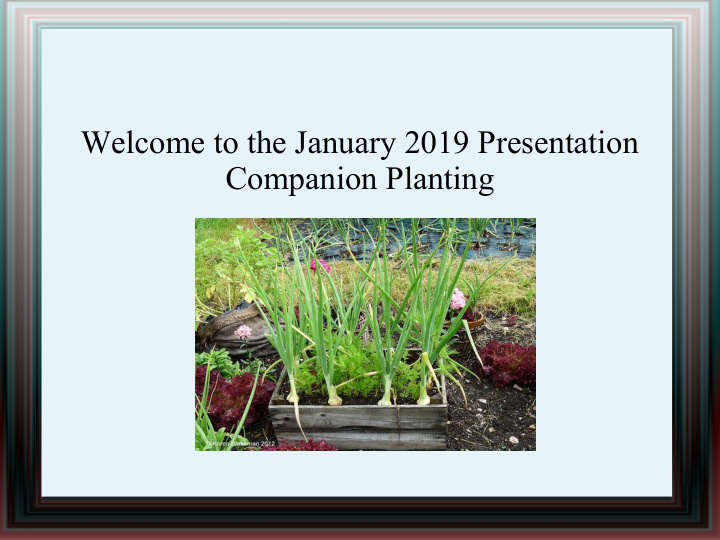



Welcome to the January 2019 Presentation Companion Planting
Agenda ● 2019 Presentations ● What is Companion Planting ● Benefits of Companion Planting ● Why Companion Planting is Effective ● Techniques ● Combinations
2019 Upcoming Presentations February: Raising Tomatoes : Richard Osterholtz March: Soil : Ann Bone April: Principles of Gardening: Tilkie Baker May: Growing Food with Mother Nature: Mike Fillon June: Pollinators: Cyndi McGill July: Hot Weather Gardening Tips and Techniques: Richard Osterholtz August: Shade Gardening: Cyndi McGill September: Cool Weather Gardening: Ann Bone October: Bees: Cindy Hodges November: Over Wintering Plants Art Simon
What is Companion Planting ● It’s the establishment of two or more plant species in close proximity so that some cultural benefit that results in higher yields is derived. ● Groups of plants which grow well together are called companions.
Origins of Companion Planting ● Traditional recommendations used by gardeners have evolved from an interesting combination of – historical observation – horticultural science, and – a few unconventional sources
Origins of Companion II ● Naturalists have known about the interactions among plants for thousands of years – About 2,000 years ago the Roman agriculturalist Varro declared "Large walnut trees close by, make the border of the farm sterile." – Native Americans three sisters of corn squash and beans is also an example of companion planting thousands years old
Benefits of Companion Planting ● Pest Control ● Controls weeds ● Makes efficient use of space – Companion plants can be planted between plants of another crop – Square foot gardening can be a type of companion planting ● Companion planting can reduce disease problems – Different species between plants can slow the spread of disease ●
Benefits II ● Can attract pollinators ● Some plants move ground water closer to the surface where it can be used by shallow rooted plants – Trees and dandilions are examples of this – Vining plants around other plants also conserve soil moisture by reducing the amount of exposed soil ● Can save labor
Why Companion Planting Works ● Biochemical Pest Suppression – some plants exude chemicals from roots or aerial parts that suppress or repel pests and protect neighboring plants ● Symbiotic nitrogen fixation – legumes have the ability to fix atmospheric nitrogen for their own use and for the benefit of neighboring plants via symbiotic relationship with Rhizobium bacteria ● Adjoining plants can crowd out weeds – Deprive weeds of sun and other resources
Insect Crop and Herb Plants that Repels Ants Onions, Tansy, Mint family Aphids Chives, Garlic, Marigolds, Mint family, Dried and crushed chrysanthemum flowers, Coriander, Onions, Oregano Cabbage Moths Rosemary, Sage, Thyme CabbageWorms Tomatoes, Celery Carrot Flies Leeks, Sage, RosemaryColorado Marigolds, Nasturtiums, Flax Potato Beetles Cucumber Beetles Nasturtiums, Radishes, Tansy Flea Beetles Catnip, Garlic Flies Basil, Tansy Leafhoppers Dried and crushed chrysanthemum flowers Mosquitoes Basil, Garlic, Geranium (citrosa) Onion Flies Garlic Ticks Garlic Tomato Worms Borage
Methods of Companion Planting ● Row intercropping – growing two or more crops at the same time with at least one crop planted in rows. ● Strip intercropping – growing two or more crops together in strips wide enough to permit separate crop production but close enough for the crops to interact. –
Methods of Companion Planting II ● Mixed intercropping – growing two or more crops together in no distinct row arrangement. – As in square foot gardening ● Relay intercropping – planting a second crop into a standing crop at a time when the standing crop is at its reproductive stage but before harvesting – Accelerated succession planting
Keep in Mind ● Companion planting is not an exact science – What works for one may not work for another – List of companion plants are based on experience of gardeners not experimentation ● Physical conditions effect results ● Experiment and see what works for you
Questions Thank You
Recommend
More recommend